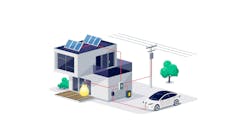Ryan Shea and Madeline Tyson of Rocky Mountain Institute show why commercial customers paying demand charges and time-of-use rates should seriously consider an investment in solar plus storage, a common technology used in microgrids.
Ryan Shea, associate RMI Cities Renewables Accelerator
As shown in a recent RMI report, battery energy storage costs are less than a fifth of what they were a decade ago. This is enabling batteries to become cost-effective in a growing list of locations and use cases, such as balancing the grid, reducing customer demand peaks, and providing backup power. In particular, behind-the-meter solar-plus-storage can often deliver bill savings for large commercial and industrial users that have high demand charges — typically greater than $10-15 per kilowatt (kW)–or have time-of-use (TOU) utility rates.
Our analysis shows that these investments have simple payback periods of less than eight years in places as diverse as Arizona, North Carolina, Ohio, and South Carolina — based just on reducing peak demand and shifting TOU. Behind-the-meter batteries can also deliver other services, but we did not model these values.
More Than Bill Savings
While solar-plus-storage is gaining market share in places with battery investment incentives, like California and New York, it is now also competitive in many less-obvious locations. To evaluate its cost-effectiveness, we modeled the optimal battery capacity to be paired with a 50-200 kW PV system for a typical commercial customer with peak monthly loads averaging around 300 kW and annual usage of 900 megawatt-hours — translating to around $150,000 per year.
We ran our model in four diverse locations — New Bern, NC; Piqua, OH; Bullhead City, AZ; and Charleston, SC – based on geographic diversity, neither obvious political support nor antipathy toward solar-plus-storage, and typically high demand charges. We used NREL’s REopt Lite online tool to quantify the customer cost savings from solar-plus-storage. We also examined, but did not quantify, other social values, such as resilience and GHG emissions reductions.
New Bern, NC (New Bern Municipal Utility)
North Carolina has the fourth-most installed solar per capita in the United States, despite having the fifth-cheapest commercial electricity rates, a moderate solar resource, and a fairly weak renewable portfolio standard (RPS), which mandates that utilities source 12.5% of their electricity from renewable sources by 2021.
Courtesy of RMI
In cities like New Bern, with high commercial demand charges (>$25/kW) coupled with TOU rate structures, solar-plus-storage can be a very attractive economic investment. The simple payback is just six years, faster even than a standalone solar PV system. For a typical medium-sized commercial customer in North Carolina spending $155,000 per year on electricity, these savings would correspond to a net present value (NPV) of $220,000.
Solar-plus-storage investments could also help New Bern adapt to and mitigate climate change. New Bern, a coastal city, has faced 24 hurricanes and severe storms since 1950, with almost half occurring in just the past decade. During future disasters, resilient solar-plus-storage systems could help keep the lights on.
Moreover, solar-plus-storage systems controlled and dispatched by the utility could also supplant planned natural gas peaker plants—especially as part of a “clean energy portfolio” that also includes energy efficiency and demand-side flexibility measures. Thus, solar-plus-storage could displace some of the 422 megawatts of natural gas plants planned over the next five years in North Carolina and help ratepayers avoid the associated risk of stranded costs.
Piqua, OH (Piqua Municipal Utility)
Ohio ranks near the bottom of the nation for installed solar per capita, with a poorer-than-average solar resource, relatively cheap electricity, and unfriendly policies—like the state legislature rolling back what was an already weak RPS of 12.5% by 2026. Battery energy storage could play an important role in jump-starting the solar industry here because it can increase solar’s cost effectiveness.
Courtesy of RMI
In places like Piqua, with high commercial demand charges ($16/kW), investments in solar-plus-storage could pay back in less than 8 years, compared with the 14-year payback period for a typical standalone solar PV system. For a typical medium-sized commercial customer in Ohio spending $105,000 per year on electricity, these savings would correspond to an NPV of $14,000.
As with North Carolina, solar-plus-storage investments also represent a significant emissions reduction opportunity. Ohio is third only to Pennsylvania and Texas in terms of planned gas generation capacity, with 2,250 megawatts expected to come online in the next five years. Showcasing the cost effectiveness of solar-plus-storage could play an important role in shifting investments away from new natural gas plants and toward clean energy portfolios.
Additionally, solar-plus-storage on critical facilities could serve as a resilient resource during grid outages. Piqua has experienced 12 federally declared disasters since 1950, including an EF4 tornado that hit just south of the town in May 2019. This resulted in over 50,000 residents losing power, some for multiple days.
Courtesy of RMI
Bullhead City, AZ (Mohave Electric Cooperative)
Despite having experienced some of the country’s biggest battles over net metering and having a fairly weak RPS of 15% by 2025, Arizona is about on par with its California and Nevada neighbors in installed solar per capita. This is due in large part to the state having the best solar resource in the United States.
Battery storage is rapidly becoming economic as well, especially for residents in cities like Bullhead City with its high commercial demand charges ($15/kW) coupled with TOU rate structures. For these customers, solar-plus-storage systems would pay back in less than seven years. For a typical medium-sized commercial customer in Arizona spending $120,000 per year on electricity, these savings would correspond to an NPV of $90,000.
Arizona is primed to become a leader in storage. Its utility regulator, the Arizona Corporation Commission, recently placed a moratorium on the construction of new gas plants, emphasizing the importance of battery storage in balancing a grid with a high portion of renewable energy.
Climate change is also a critical factor for Arizona, which recently experienced increased wildfires, extreme temperatures, and drought. Bullhead City has experienced 13 federally declared disasters since 1950, including recent wildfires in 2013 and 2015. As with other cities feeling the heat from climate change, resilient solar-plus-storage systems could alleviate some of the impacts from grid outages.
Charleston, SC (Coastal Electric Cooperative)
Courtesy of RMI
Even though South Carolina has a better solar resource and higher electricity prices than North Carolina, a combination of unfriendly solar policies has resulted in it having less than a third of the installed solar per capita of its northern neighbor. This includes a practically nonexistent RPS of 2% by 2021, a recently lifted 2% aggregate cap on net metering, and the Public Service Commission setting abnormally low rates for solar projects through PURPA.
Despite these regulator headwinds, solar-plus-storage systems can pay back in less than seven years in cities like Charleston, which is subject to Coastal Electric Cooperative’s high demand charges (>$16/kW) and TOU rate structures. For a typical medium-sized commercial customer in South Carolina spending $150,000 per year on electricity, these savings would correspond to an NPV of $82,000.
Similarly to New Bern, NC, Charleston has experienced 17 disasters from hurricanes and severe storms since 1950, including 12 in just the last six years. Resilient solar-plus-storage systems can help Charleston deal with the effects of these increasingly frequent natural disasters. And as nuclear powers continue to falter in the state, costing rate payers billions of dollarssolar-plus-storage is well-positioned to become a critical part of a more distributed, cleaner, and lower-cost electricity system for South Carolina.
It’s Time to Get Serious About Storage
It no longer makes any sense to say that batteries are too expensive. Solar-plus-storage could be a significant missed investment opportunity for places that don’t properly evaluate the many benefits described above—especially those with high commercial demand charges or TOU rates.
Cities can play a unique role in helping to build the industry by developing goals, policies, and siting and safety guidelines for battery energy storage. New York City has taken a great first step, developing useful tools that other cities could use to develop best practices in these areas.
In addition to cities, corporate and institutional energy customers should take the lead by assessing solar-plus-storage on their buildings to evaluate the direct bill savings and their ability to adapt to and mitigate the effects of climate change. Collectively, the buying power of these customers could help significantly move the needle on battery storage deployment and be an important accelerant of our transition to a cleaner grid
©2020 Rocky Mountain Institute. Published with permission. Originally posted on RMI.org Outlet.







